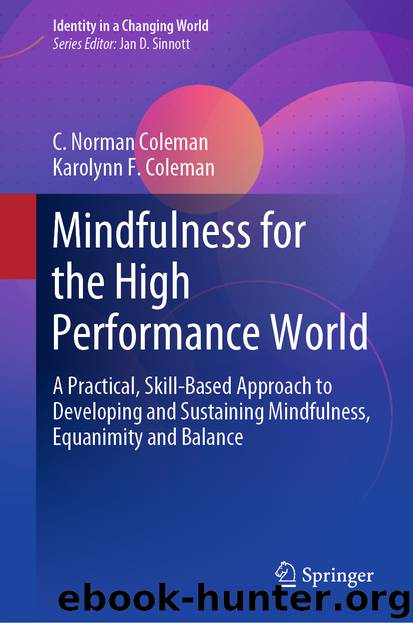Mindfulness for the High Performance World by C. Norman Coleman & Karolynn F. Coleman

Author:C. Norman Coleman & Karolynn F. Coleman
Language: eng
Format: epub
ISBN: 9783030185824
Publisher: Springer International Publishing
In the top part of this figure is illustrated the sequence of stabilizing (S) and insight (I) meditation. To quiet and stabilize the mind, one focuses on breathing. This requires effort and at times, it may be necessary to exaggerate the breathing to focus on it. In some sessions, there is so much mental turmoil that one hardly gets past Stabilizing meditation. Yet, the time spent doing that will bring some relief and progress. At some sessions, there may be times of open awareness which may come and go but once experienced one will realize that the mental cycles and racing thoughts can be tamed and what is left is a quieted mind with only awareness left. This is discussed in Chap. 7.
Next one goes to the insight meditation which is observing sensations. The breath is used here, not to focus on, but to observe. As one gets agitated, the breathing becomes deeper and irregular so an occasional check to see what is happening with the breath is useful. Observation of biochemical and physiological changes is done in a careful, methodical and sequential way so that not just the more obvious sensations are observed. Over time, one learns to sense very subtle changes both on the external body, where sensory nerve endings are plentiful, and also on internal sources of sensations such as muscle tension. This may take years to fully accomplish but even early skills are extraordinarily useful. (One can go a long way in an initial course).
With experience and practice, it will become possible to have an extended period of time in insight meditation. But even the experts become distracted at which point returning to the focus on the breath, the stabilizing technique, is useful. A meditation session may include a number of these changes from Stabilizing to Insight. As discussed below, some techniques use a “loving-kindness” or “metta” component (M) to enter a positive mind-set at the end. This may not be possible during a very difficult session.
The power of observation is illustrated in the lower portion of Fig. 6.5. As one observes the sensations, the sensation-reaction cycle often coming from thoughts deep within the mind begins to surface. By observing and not reacting, this will eventually dissipate and even disappear. The same cycle may be repeated many times but by not attaching to it with a craving or aversion and just observing it will lessen in intensity and fade. As one reaction cycle goes, others will arise, often from very deep within the mind, and they, too, will disappear with observation. The cause of the cycle, say fear or anger, may not be known but the weakening of the mental reaction not only makes one feel better and more clear but the underlying reason for a certain feeling may suddenly come to the surface. These epiphanies do occur and are stunning in how some deep-seated problem suddenly is understood and goes away. (We know this from experience.)
As one becomes more proficient at observation, the mind will
Download
This site does not store any files on its server. We only index and link to content provided by other sites. Please contact the content providers to delete copyright contents if any and email us, we'll remove relevant links or contents immediately.
Rewire Your Anxious Brain by Catherine M. Pittman(18589)
Talking to Strangers by Malcolm Gladwell(13290)
The Art of Thinking Clearly by Rolf Dobelli(10321)
Mindhunter: Inside the FBI's Elite Serial Crime Unit by John E. Douglas & Mark Olshaker(9260)
Becoming Supernatural by Dr. Joe Dispenza(8166)
Change Your Questions, Change Your Life by Marilee Adams(7684)
Nudge - Improving Decisions about Health, Wealth, and Happiness by Thaler Sunstein(7656)
The Road Less Traveled by M. Scott Peck(7555)
The Lost Art of Listening by Michael P. Nichols(7453)
Mastermind: How to Think Like Sherlock Holmes by Maria Konnikova(7278)
Enlightenment Now: The Case for Reason, Science, Humanism, and Progress by Steven Pinker(7272)
Win Bigly by Scott Adams(7139)
The Way of Zen by Alan W. Watts(6548)
Daring Greatly by Brene Brown(6473)
Big Magic: Creative Living Beyond Fear by Elizabeth Gilbert(5676)
Grit by Angela Duckworth(5554)
Ego Is the Enemy by Ryan Holiday(5347)
Men In Love by Nancy Friday(5192)
The Laws of Human Nature by Robert Greene(5080)
